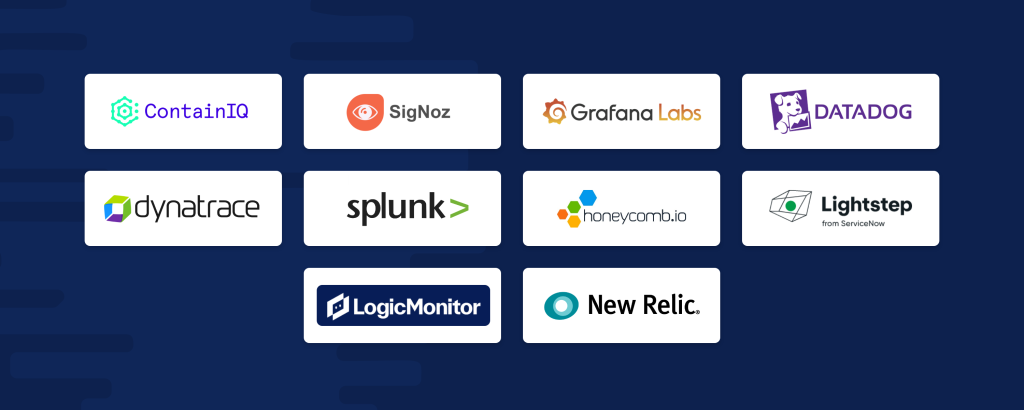
The observability landscape in 2024 is bustling with innovation and change. Here’s a comprehensive overview of key trends and prominent tools to help you navigate this exciting space:
Key Trends:
- Focus on data democratization: Making data accessible and actionable for all stakeholders, not just engineers.
- Rise of AI and machine learning: Tools leverage AI for anomaly detection, root cause analysis, and automated issue resolution.
- Open-source gaining traction: Tools like Prometheus and Grafana becoming mainstream solutions alongside proprietary platforms.
- Cloud-native observability tools: Solutions specifically designed for cloud environments, offering seamless integration and scalability.
- Increased focus on cost optimization: Tools helping organizations monitor and manage resource utilization for cost-effective observability.
Prominent Tools:
Full-Stack Observability Platforms:
- Datadog: Comprehensive solution for APM, infrastructure monitoring, log management, and tracing. User-friendly dashboards and AI-powered features.
- New Relic: Robust APM platform with deep code-level insights, real-time performance monitoring, and advanced analytics capabilities.
- Dynatrace: AI-powered solution for full-stack monitoring, providing automatic problem detection, root cause analysis, and proactive resolution.
Metrics and Tracing Tools:
- Prometheus: Open-source platform for collecting and exporting metrics, highly customizable and extensible. Works well with Grafana for visualization.
- Jaeger: Open-source tracing system for distributed systems, providing insights into request flows and performance bottlenecks.
- OpenTelemetry: Open-source framework for collecting and exporting data, vendor-neutral and cloud-agnostic.
Log Management Tools:
- ELK Stack (Elasticsearch, Logstash, Kibana): Open-source log management solution with powerful search, analysis, and visualization capabilities.
- Splunk: Industry leader in log management, offering advanced analytics, reporting, and compliance features.
- Graylog: Open-source log management solution with user-friendly interface and strong community support.
Cloud-Native Monitoring Tools:
- Amazon CloudWatch: Built-in service for AWS, offering cost-effective monitoring for smaller setups and deep integration with AWS services.
- Azure Monitor: Comprehensive solution for Azure environment monitoring, including infrastructure, containers, and applications.
- Google Cloud Monitoring: Integrated solution for GCP monitoring, with strong emphasis on scalability and data analysis.
Other Notable Tools:
- Grafana: Powerful visualization tool for time series data, often paired with Prometheus and other monitoring systems.
- Honeycomb: Scalable tool for analyzing event-based data, excelling in troubleshooting complex distributed systems.
- Prometheus Operator: Kubernetes-native solution for managing and deploying Prometheus in containerized environments.
Choosing the Right Tool:
Selecting the best tool depends on various factors:
- Infrastructure footprint: On-premises, cloud, or hybrid environment?
- Monitoring needs: Application performance, infrastructure health, security, or specific metrics?
- Budget: Open-source, freemium, or paid subscription?
- Technical expertise: Ease of use and administration requirements.
- Integration needs: Compatibility with existing tools and workflows.
Best Practices for Effective Observability:
- Define clear goals: Identify what you want to achieve with observability.
- Implement centralized monitoring: Consolidate data from various sources for holistic insights.
- Analyze and visualize data: Gain actionable insights through data analysis and visualization tools.
- Automate routine tasks: Streamline operations and reduce manual effort.
- Continuously improve: Regularly review and optimize your observability setup.
Beyond the Tools:
Remember, the right tools are only part of the equation. It’s crucial to build a culture of observability within your organization, encouraging data-driven decision making and proactive problem solving.
Say goodbye to the hassles of bike ownership! MotoShare.in offers affordable rentals, whether you need a scooter for errands, a bike for a road trip, or a reliable ride to explore new cities.

 Starting: 1st of Every Month
Starting: 1st of Every Month  +91 8409492687
+91 8409492687  Contact@DevOpsSchool.com
Contact@DevOpsSchool.com
